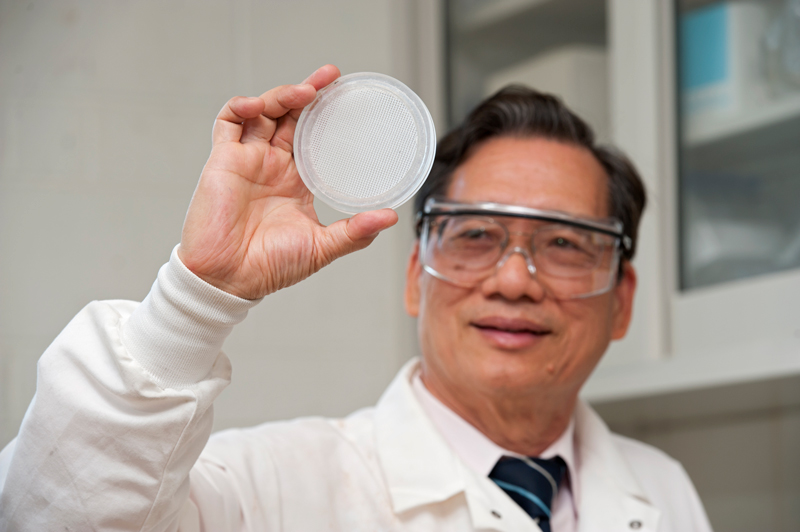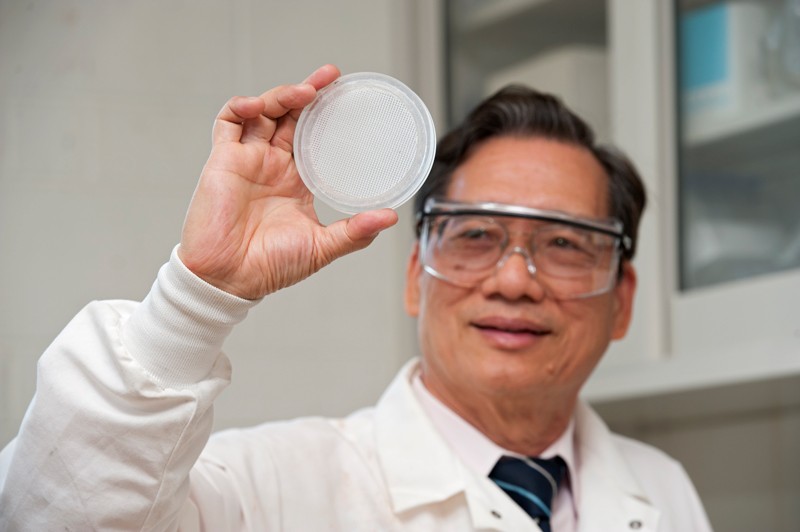Article by Karen B. Roberts | Photo by Evan Krape
UD-invented technology selectively filters perchlorate from water
Click here to watch video.
In June, the Environmental Protection Agency issued a request for public comment on a proposed rule for regulating perchlorate in public drinking water systems.
Perchlorate, a natural and man-made chemical, is considered an emerging contaminant that is difficult to remove from the environment. It is the primary residue left over from rocket fuels, fireworks and explosives and can be found in common items, such as fertilizer and roadside flares. It also is valued in laboratory experiments for its ability to aid in the combustion of other chemicals, while remaining chemically inactive.
Reports of perchlorate contamination in soil, water and food have been recorded in many countries worldwide, including in the United States, Japan, China, Canada, Colombia, Greece and South Korea. It’s a problem that may have implications for human health. According to the National Institutes of Health’s National Center for Biotechnology, in high doses, perchlorate inhibits thyroid hormone production in humans by interfering with the thyroid’s uptake of iodine.
University of Delaware environmental engineer Chin-Pao Huang, the Donald C. Phillips Professor in the Department of Civil and Environmental Engineering, has been studying ways to remove perchlorate from drinking water for nearly a decade.

University of Delaware Professor Chin-Pao Huang and alumnus Po-Yen Wang (not pictured), now an assistant teaching professor at Widener University, have patented a novel membrane that can selectively filter perchlorate from drinking water, with the help of UD’s Office of Economic Innovation and Partnerships.
Now, Huang and Po-Yen Wang, a former doctoral student and now an assistant teaching professor at Widener University, have patented a novel membrane that can selectively filter perchlorate from drinking water. The researchers patented the idea with the help of UD’s Office of Economic Innovation and Partnerships (OEIP).
UD-developed technology
According to Huang, perchlorate is toxic even at low levels. A 2005 National Research Council reportestimated that over 11 million Americans had perchlorate in their public drinking-water supplies at concentrations of 4 parts per billion or higher, which is the equivalent of four drops of the chemical in 10,000 gallons of water.
Huang said a method called “ion exchange” concentrates the perchlorate onto tiny resin beads that can be removed from the drinking water. The perchlorate adsorbs onto the surface of the beads and, once saturated, the beads are removed, but there currently is no standard method for disposing of the beads or for rendering them nontoxic.
Huang said this is a gray area because while the EPA realizes perchlorate in water is a problem and that its removal is important for human health, the technology is just not there yet. This is where the UD-developed technology can help.
The UD-developed membrane can selectively concentrate the perchlorate and then reduce the chemical to chloride, which is nontoxic at these concentrations, using electricity and a bimetallic rhodium-copper catalyst electrode. Experiments to date demonstrate that the UD-developed process can be done with 78% efficiency.
Wang developed the method while he was a graduate student at UD, but it took seven years to figure out the right combination of materials to make the process work. Another doctoral student, Ching-lung Chen, furthered work to develop the novel catalyst (made of palladium and copper) that is used today. The researchers recently reported their results in the American Society of Civil Engineers’ Journal of Environmental Engineering.
Importantly, the chemical reduction process Huang’s research team created can be used in conjunction with the UD-developed filtering membrane, but also is suitable as an added technology to complement currently accepted industry methods for removing perchlorate in public drinking water.
According to Huang, the same methods used to electrochemically reduce concentrated perchlorate filtered through the UD-developed membrane can be applied to resin beads currently used in industrial processes to remove perchlorate from drinking water. In this way, Huang theorizes the resins might be regenerated for reuse rather than disposed of as hazardous waste (an expensive practice), simultaneously mitigating the financial burden and protecting the environment.
Huang conceded that while the technology holds promise, its success really depends on EPA policy.
“Unfortunately, it doesn’t look like the problem will be going away. But perhaps the technique we developed might be useful for those seeking to influence policy changes on perchlorate standards,” said Huang.
Already more than a half-dozen states in the U.S., including Arizona, California, Maryland, Massachusetts, New York, Nevada, New Mexico and Texas, have set state standards for the amount of allowable perchlorate in drinking water.
A champion for water quality
Though Huang has been a faculty member at UD since 1974 — he celebrates 45 years of service to UD in 2019 — this is his first patent. True, he has had previous research projects and ideas. Some ideas even “appeared to be quite patentable.” But without OEIP, Huang said, it wasn’t something he would have attempted. In particular, Huang credited the technology transfer team within OEIP for helping him navigate the process with ease.
“The preparation of patent documents and following up with the patent granting agency is time consuming and requires professional know-how. I’m grateful to the University for establishing an office like OEIP to assist faculty with interests in intellectual property and to OEIP for staffing it with knowledgeable experts,” Huang said. “It is a long process and without their assistance I would not have been able to sustain the process, let alone the final success.”
UD undergraduates were involved in the project, too. Through OEIP’s Spin-In program, three undergraduate students participated in early work, providing the researchers a business plan and an early 3D-printed prototype of the reactor that, today, enables perchlorate to be reduced to nontoxic chloride.
As part of its ongoing efforts on behalf of the University, OEIP is working to secure a partner to assist in commercializing this technology.
Water quality has been a major focus of Huang’s work, with research spanning issues around access, affordability, water quality, water treatment and more. He co-founded the International Conference on Sustainable Water Environment, which has been in operation for 16 years among hosting countries including the U.S., China, Taiwan, Korea, Japan and Singapore.
In a new research thrust, Huang is initiating studies with a colleague in Taiwan to shed light on another emerging pollutant: the presence of nanoplastics in our freshwater supply.
Microplastics, filaments and particles that range in size from 100 nanometers to less than five millimeters, have made headlines recently due to study findings about their presence in the ocean and in marine life. Nanoplastics are up to 1,000 times smaller than microplastics, ranging in size from 10 to 100 nanometers. To lend perspective, the average human hair is approximately 80,000 to 100,000 nanometers wide.
“Microplastics are too big for me — microplastics you can see under a microscope; nanoplastics you can’t,” Huang said.
As microplastics continue to break down, they create smaller and smaller particles called nanoplastics that can find their way into many food and water sources. Some reports question whether nanoplastics are small enough to penetrate a cell wall, raising important questions about what, if any, threat these tiny travelers may pose to the environment, our water supply and our health.
Huang aims to find out.
This work is supported through a grant from the National Science Foundation’s Environmental Engineering Program, Division of Chemical, Bioengineering, Environmental and Transport Systems (Grant #0965984

